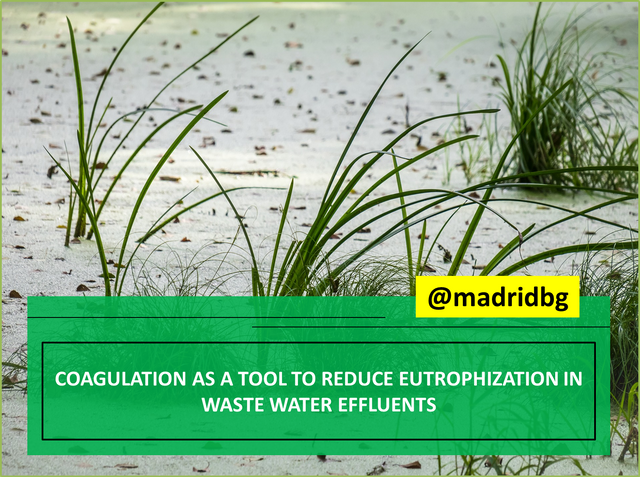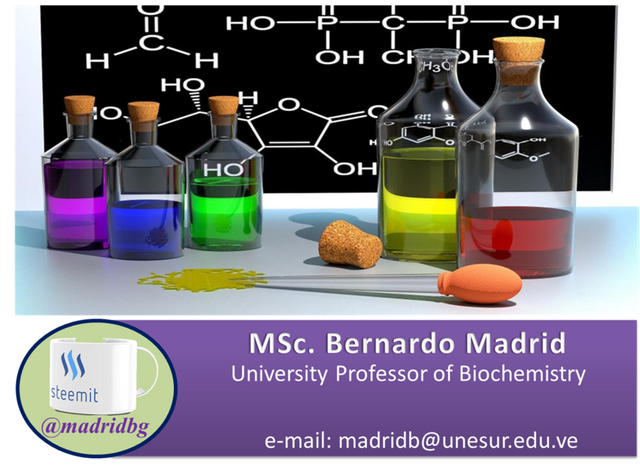
Author: @madridbg, through Power Point 2010, using images in the public domain. Thomas B
Greetings and welcome dear readers of the #steemitblog platform, who follow me daily in this space of scientific dissemination with academic and practical implications. The present publication is focused on the study of coagulating agents of natural and synthetic origin as a mechanism to cope with the process of eutrophication in wastewater effluents.
Conceptually, the eutrophication process is conceived as an exponential growth of phytoplankton as a consequence of a generalized increase of nutrient levels in the aquatic space, due to the daily activities of man.

Fig. 2. The process of eutrophication threatens water quality. Author: 1778011
Among the nutrients that accumulate more and generate more nutritional contribution on the plant species are phosphorus and nitrogen, although in some ways eutrophication is a natural process that shows us the aging state of the water in lakes, human activity has exponentially increased the development of this process.
This process begins with the appearance of species such as diatoms and chlorophyceae, which give rise to the appearance of cyanobacteria, responsible for the consumption of the entire reservoir of nitrogen and phosphorus present in the water, accumulating on the surface and preventing solar radiation from penetrating to the bottom of the water, causing the photosynthetic processes in the depths to stop, which will end in a slow decomposition of the aquatic space.
With this in mind, Global Omnium Spain has developed a sophisticated scientific process based on the use of natural coagulants to limit the excessive concentration of nitrogen and phosphorus in wastewater treatment water, so that this mechanism can be evaluated and expanded on a large scale.
We must remember that in many developed countries, wastewater is treated and then returned to human use, hence the eutrophication of these water sources increases economic losses due to damage to the equipment used for this purpose, in addition to causing aging and decomposition of the water due to the processes being studied.

Fig. 3. Wastewater treatment plant. Author: kubinger
Methodologically, the project is based on the use of biopolymers of natural origin with similarities to carbohydrates, which act as coagulation and flocculation agents that allow them to compete with algae in order to obtain a higher concentration of phosphorus and nitrogen, preventing them from generating an exponential growth due to the lack of nutrients and best of all, the product used is biodegradable so it does not harm the environment.
It is necessary to remember that the main discharges of phosphorus come from the agricultural industry and from those companies dedicated to the manufacture and distribution of fertilizers, as well as the use of detergents and cleaning products. In the pilot tests carried out, a reduction of more than 64% in the presence of phosphorus has been achieved, a significant figure in view of the objectives pursued, so that the treatment of water using this methodology seems to be very effective in the process of water aging.
BIBLIOGRAPHICAL REFERENCES CONSULTED

[1] Fátima García y Verónica Miranda. Eutrophication, a threat to water resources. Article: Online Access
[2] WADE,LEROY. (2011). . QUÍMICA ORGÁNICA. VOLUMEN 2. SÉPTIMA EDICIÓN. PEARSON EDUCACIÓN, MÉXICO, 2011 ISBN: 978-607-32.()793•5. ÁREA: CIENCIAS
OF INTEREST

•

Grateful with the community @project.hope and with all the management team of the same one that they motivate us to continue working in a mutual and balanced growth.


Definitely, an excess of nutrients leads to this process that destroys the balance of the ecosystem. In the face of this situation, a thorough study must be made to evaluate the cause. Good article
Downvoting a post can decrease pending rewards and make it less visible. Common reasons:
Submit